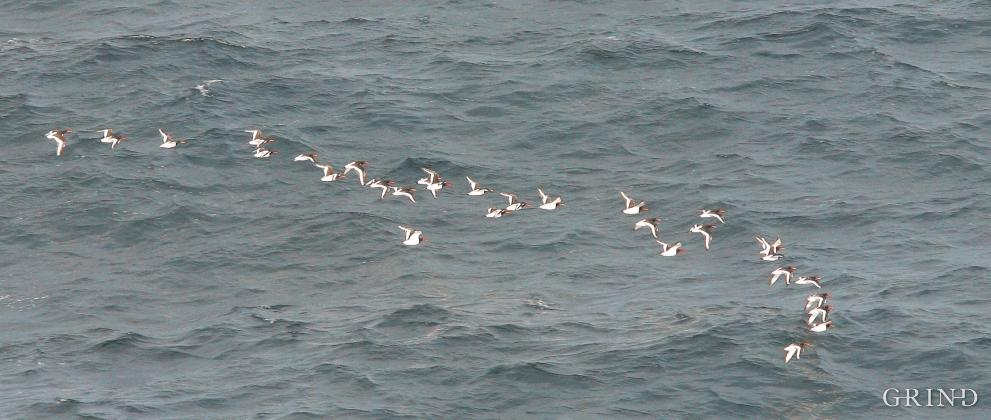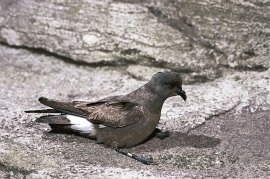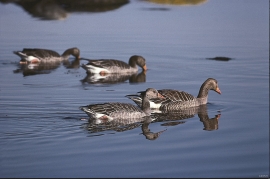Published: 05.08.2015 | Author: Stein Byrkjeland
BIRD MIGRATIONS OFF SKOGSØYNA
There isn't much forest on Skogsøyna today, but that there is, has been planted. There is not much wildlife, either. But, quite a lot of birds pass by Skogsøyna during migration time. Ther is no other place along the coast where you can better observe the seabird migrations.
The top southwest of the island, three quarters of an hours' walk from the road, is the best viewpoint. The path begins by a little gate on the ground down toward the bridges to Herdlevær. The bird migration is easiest to see early in the morning and a bit later in the morning. The migration lasts from April until June, and the autumn migration from the end of July to October. Binoculars are essential to get the full experience, which is even more enhanced through a telescope.
Seabirds dominate. The Herring Gull and the Common Gull are most abundant, but there are also large populations of Northern Gannet, Greater Cormorant, Grey Goose, Oystercatcher (picture) and other wading birds passing by. Farther out, the rarer Sooty Shearwater passes by, and some days also many loons. After a number of days with strong landward-driving winds, one may see many Arctic petrels just outside of Skogsøyna. In over land, it is flocks of thrushes and Red-throated Pipits that one notices most.
There are most migratory birds in the autumn. On the busiest autumn days, well over 10 000 birds of many different species may pass by. It is well worth observing the spring migrations, also. Gulls are most abundant, but there can also be a lot of Red-throated Divers in April and early May. Some days, several hundred Arctic skua and Long-tailed Skua pass by, but this migration is quite concentrated in a narrow interval of time. Even more time-limited is the migration of the Brent Goose. During a single hour one May day , most of the entire Svalbard population of about 4000 individuals might fly by. When Danish ornithologists documented that the birds abandoned their over-wintering spots in Lim Fjord on Jylland, the alarm goes off! Bird enthusiasts in the Bergen area hop in their cars and head for Skogsøyna so that they can experience when the Brent geese fly by a few hours later. If one knows the point of departure from Denmark and the distance -and the wind is not too strong - one can plan the observation of their passage nearly to the minute.
Light sensitive activity
You have probably never seen a British Storm-Petrel. It is a little, dark seabird who stays out on the sea during the day, but comes in toward the coast at night. From the beacon on Skogsøyna over 700 Storm Petrels were lured in during the period from 1992-1997, and these were ringed here. Ornithologists used strong cassette recordings and a megaphone to broadcast Storm Petrel sounds out over the big ocean. And the birds let themselves be enticed.
Such ring-marking is only possible on still August nights. Then, it is dark enough, so the Storm Petrels do not see the trapping nets. The Storm Petrel is both a bit shady and mysterious bird. Many of the Storm Petrels that are caught at Skogsøyna were ringed earlier at very different places (such as Røst, Sunnmøre, Shetland and Færo Islands), and they travel far in a short time, even though it might be in the middle of the nesting season. On average, one in four trapped birds have a ring on their foot from before. Their pattern of travel is nonetheless difficult to interpret. It is possible that the parent birds have to fly to the other side of the North Sea in order to find plankton - while the hungry youngsters must lie in their nests and wait for the cold dinner leftovers from yesterday. (Frode Falkenberg)
- Byrkjeland, S.; Svenkerud, K.; Hansen, K.A.; Sætersdal, M. 1982. Fugletrekket ved Skogsøy. Øygarden høsten 1981. Krompen 11:45–56
- Svenkerud, K.; Hansen, K. A.; Mjøs, A. T. 1983. Fugletrekket ved Skogsøy, Øygarden våren 1982. Krompen 12:58–69.
- Tjensvoll, N.-I. 2002. Havsvalemerking. Krompen 31:120–122.





